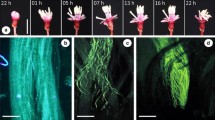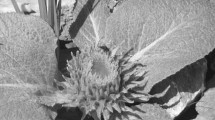Abstract
From field observations onDrimys brasiliensis, principally in the Botucatu region of São Paulo State, Brazil, new data on the reproductive biology, the rhythm of growth, and the development of lateral cymose inflorescences, flowers and fruits are presented. Pollination accelerates the rate of flower-development for about 4–6 days. Pollination experiments show thatD. brasiliensis is not self-sterile; because of mechanical devices the sticky pollen grains do not normally come into contact with the stigmata unless an animal pollen vector is involved. The pollinators are diurnalColeoptera, Diptera andThysanoptera which eat from the pollen, lick from the stigmatic exudates and (in case of the flies) probably also from the staminal glands. Fruit- and seedeaters are birds which seem to be the main dispersal agents. Establishment of new individuals normally is through seedlings, but also by vegetative propagation through plagiotropous branches which may root and separate from the mother plant. The morphological, developmental and reproductive aspects inD. brasiliensis are discussed in a wider context, compared with data from otherMagnoliidae, and related to aspects of early Angiosperm evolution.
Similar content being viewed by others
References
Bailey, I. W., Nast, Ch. G., 1943: The comparative morphology of theWinteraceae. I. Pollen and stamens. — J. Arn. Arb.24, 340–346.
,, 1945: The comparative morphology of theWinteraceae. VII. Summary and conclusions. — J. Arn. Arb.26, 37–47.
Baum, H., 1949: Beiträge zur Kenntnis der Schildform bei den Staubblättern. — Österr. Bot. Z.96, 353–466.
Boer, R. de, Bouman, F., 1974: Integumentary studies in thePolycarpicae. III.Drimys winteri (Winteraceae). — Acta Bot. Neerl.23, 19–27.
Buchheim, G., 1964: 15. ReiheMagnoliales. — InMelchior, H. (Ed.):A. Englers Syllabus der Pflanzenfamilien, 12. Aufl., 108–131. — Berlin-Nikolassee: Gebr. Borntraeger.
Burck, W., 1890: Über Kleistogamie im weiteren Sinn und dasKnight-Darwinsche Gesetz. — Ann. Jard. Bot. Buitenzorg8, 122.
Carlquist, S., 1969: Toward acceptable evolutionary interpretations of floral anatomy. — Phytomorphology19, 332–362.
Corner, E. J. H., 1940: Wayside Trees of Malaya1. — Singapore: Government Printing Office.
, 1953: The Durian theory extended, I. — Phytomorphology3, 465–476.
, 1954: The Durian theory extended, II. The arillate fruit and the compound leaf. — Phytomorphology4, 152–165.
, 1976: The Seeds of Dicotyledons1. — Cambridge: Univ. Press.
Cramer, J. M., Meeuse, A. D. J., Teunissen, P. A., 1975: A note on the pollination of nocturnally flowering species ofNymphaea. — Acta Bot. Neerl.24, 489–490.
Cronquist, A., 1968: The Evolution and Classification of Flowering Plants. — Boston: Houghton Mifflin Company. papers no.9.
Downes, J. A., 1973: Endopterygote insects and the origin of the Angiosperm flower. — First Internat. Congr. System. Evol. Biol., Boulder, Colorado, 4–12 Aug. 1973, Abstr. contrib. papers no.9.
Ehrendorfer, F., Silberbauer-Gottsberger, I., Gottsberger, G., 1979: Variation on the population, racial and species level in the primitive relic Angiosperm genusDrimys (Winteraceae) in South America. — Pl. Syst. Evol.132, 53–83.
Endress, P. K., 1977: Über Blütenbau und Verwandtschaft derEupomatiaceae undHimantandraceae (Magnoliales). — Ber. Deutsch. Bot. Ges.90, 83–103.
Frankel, R., Galun, E., 1977: Pollination Mechanisms, Reproduction and Plant Breeding. — Berlin-Heidelberg: Springer.
Fries, R. E., 1959:Annonaceae. — InEngler, A. Prantl, K. (Ed.): Die natürlichen Pflanzenfamilien, 2. Aufl.,17 a II, 1–171. — Berlin: Duncker & Humblot.
Gibbs, P. E., Semir, J., Cruz, N. D. da, 1977: Floral biology ofTalauma ovata St. Hil. (Magnoliaceae). — Ciência e Cultura29, 1436–1441.
Gottsberger, G., 1970: Beiträge zur Biologie von Annonaceen-Blüten. — Österr. Bot. Z.118. 237–279.
, 1974: The structure and function of the primitive Angiosperm flower. — Acta Bot. Neerl.23, 461–471.
, 1977a: A cantarofilia emTalauma ovata (Magnoliaceae). — XXVIII Congr. Nac. Bot., Belo Horizonte, Minas Gerais, 23–30 Jan. 1977, Abstr. Sessão TecnicaII, 14.
, 1977b: Some aspects of beetle pollination in the evolution of flowering plants. — Pl. Syst. Evol., Suppl.1, 211–226.
, 1978: Seed dispersal by fish in the inundated regions of Humaitá, Amazonia. — Biotropica10, 170–183.
Grant, V., 1950: The pollination ofCalycanthus occidentalis. — Amer. J. Bot.37, 294–297.
Hamilton, A. G., 1897: On the fertilisation ofEupomatia laurina R. Br. — Proc. Linn. Soc. New South Wales22, 48–55.
Heiser, Ch. B., 1962: Some observations on pollination and compatibility inMagnolia. — Proc. Indiana Acad. Sci.72, 259–266.
Hiepko, P., 1965: Vergleichend-morphologische und entwicklungsgeschichtliche Untersuchungen über das Perianth bei denPolycarpicae. I. und II. Teil. — Bot. Jahrb.84, 359–508.
, 1966: Das Blütendiagramm vonDrimys winteri J. R. etG. Forst. (Winteraceae). — Willdenowia4, 221–226.
Hotchkiss, A. T., 1958: Pollen and pollination in theEupomatiaceae. — Proc. Linn. Soc. New South Wales83, 86–91.
Leinfellner, W., 1956a: Die blattartig flachen Staubblätter und ihre gestaltlichen Beziehungen zum Bautypus des Angiospermen-Staubblattes. — Österr. Bot. Z.103, 247–290.
, 1956b: Inwieweit kommt der peltat-diplophylle Bau des Angiospermen-Staubblattes in dessen Leitbündel-Anordnung zum Ausdruck? — Österr. Bot. Z.103, 381–399.
, 1966: Über die Karpelle verschiedenerMagnoliales. I. — Österr. Bot. Z.113, 383–389.
, 1969: Über die Karpelle verschiedenerMagnoliales. VIII. Überblick über alle Familien der Ordnung. — Österr. Bot. Z.117, 107–127.
Leppik, E. E., 1975: Morphogenic stagnation in the evolution ofMagnolia flowers. — Phytomorphology25, 451–464.
Nast, Ch. G., 1944: The comparative morphology of theWinteraceae. VI. Vascular anatomy of the flowering shoot. — J. Arn. Arb.25, 454–466.
Pervukhina, N. V., 1967: The pollination of the primary Angiosperms and the evolution of modes of pollination (Russ.). — Bot. Ž. (Moskow)52, 157–188.
Pijl, L. van der, 1953: On the flower biology of some plants from Java. — Ann. Bogor.1, 77–99.
, 1955: Sarcotesta, aril, pulpa and the evolution of the Angiosperm fruit, I, II. — Proc. Ned. Acad. Wet. (C)58, 307–312.
, 1966: Ecological aspects of fruit evolution, a functional study of dispersal organs, I, II, III. — Proc. Ned. Acad. Wet. (C)69, 597–640.
, 1969a: Principles of Dispersal in Higher Plants. — Berlin-Heidelberg: Springer.
, 1969b: Evolutionary action of tropical animals on the reproduction of plants. — Biol. J. Linn. Soc.1, 85–96.
Porsch, O., 1957: Alte Insektentypen als Blumenausbeuter. — Österr. Bot. Z.104, 115–164.
Prance, G. T., Anderson, A. B., 1976: Studies of the floral biology of neotropicalNymphaeaceae. 3. — Acta Amazonica6, 163–170.
, 1975: A study of the floral biology ofVictoria amazonica (Poepp.)Sowerby (Nymphaeaceae). — Acta Amazonica5. 109–139.
Raven, P., Kyhos, D. W., 1965: New evidence concerning the original basic chromosome number of Angiosperms. — Evolution19, 244–248.
Rickett, H. W., 1944: The classification of inflorescences. — Bot. Rev.10. 187–231.
Sampson, F. B., 1974: A new pollen type in theWinteraceae. — Grana14. 11–15.
Schuster, R. M., 1976: Plate tectonics and its bearing on the geographical origin and dispersal of Angiosperms. — InBeck, Ch. B. (Ed.): Origin and Early Evolution of Angiosperms, p. 48–138. — New York-London: Columbia Univ. Press.
Skottsberg, C., 1928: Pollinationsbiologie und Samenverarbeitung auf den Juan Fernandez-Inseln. — InSkottsberg, C. (Ed.): The natural history of Juan Fernandez and Easter Island. Vol. 2, 503–547.
Smith, A. C., 1943: The American species ofDrimys. — J. Arn. Arb.24, 1–33.
Stebbins, G. L., 1973: Evolutionary trends in the inflorescence of Angiosperms. — Flora162, 501–528.
Takhtajan, A., 1958: Origins of Angiospermous plants. — Washington, D.C.: Amer. Inst. Biol. Sci.
, 1959: Die Evolution der Angiospermen. — Jena: G. Fischer.
, 1969: Flowering Plants, Origin and Dispersal. — Edinburgh: Oliver and Boyd.
, 1970: Proiskhozhdenie i Rasselenie Tsvetkovykh Rastenii. — Leningrad: Akademia Nauk, Bot. Inst. V. L. Komarov.
Thien, L. B., 1974: Floral biology ofMagnolia. — Amer. J. Bot.61, 1037–1045.
- 1976: The pollination ofDrimys sect.Tasmannia. — J. Bot. Soc. Amer., meeting 21–26 Aug. 1976, abstr., 20–21.
Troll, W., 1964: Die Infloreszenzen1. — Stuttgart: G. Fischer.
Tucker, S. C., 1959: Ontogeny of the inflorescence and the flower inDrimys winteri var.chilensis. — Univ. Calif. Publ. Bot.30, 257–336.
, 1972: The role of ontogenetic evidence in floral morphology. — Adv. Pl. Morph.1972, 359–369.
,Gifford, Jr., E. M., 1966a: Organogenesis in the carpellate flower ofDrimys lanceolata. — Amer. J. Bot.53, 433–442.
,, 1966b: Carpel development inDrimys lanceolata. — Amer. J. Bot.53, 671–678.
Vink, W., 1970: TheWinteraceae of the Old World. I.Pseudowintera andDrimys—morphology and taxonomy. — Blumea18, 225–354.
Walker, J. W., 1976: Comparative pollen morphology and phylogeny of the Ranalean complex. — InBeck, Ch. B. (Ed.): Origin and Early Evolution of Angiosperms, 241–299. — New York-London: Columbia Univ. Press.
, 1975: The bases of Angiosperm phylogeny: palynology. — Ann. Missouri Bot. Gard.62, 664–723.
Wester, P. J., 1910: Pollination experiments with Anonas. — Bull. Torrey Bot. Cl.37, 529–539.
Winkler, H., 1907: Beiträge zur Morphologie und Biologie tropischer Blüten und Früchte. — Bot. Jahrb.38, 231–271.
Zimmermann, W., 1965: Die Blütenstände, ihr System und ihre Phylogenie. — Ber. Deutsch. Bot. Ges.78, 3–12.
Author information
Authors and Affiliations
Rights and permissions
About this article
Cite this article
Gottsberger, G., Silberbauer-Gottsberger, I. & Ehrendorfer, F. Reproductive biology in the primitive relic AngiospermDrimys brasiliensis (Winteraceae). Pl Syst Evol 135, 11–39 (1980). https://doi.org/10.1007/BF00983005
Received:
Accepted:
Issue Date:
DOI: https://doi.org/10.1007/BF00983005




